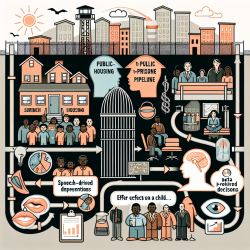Introduction
Benign hereditary chorea (BHC) is a rare, autosomal dominant disorder characterized by early-onset, non-progressive involuntary movements. While mutations or deletions in the NKX2-1 gene have been traditionally associated with BHC, recent research has identified a novel disease-causing mechanism involving non-coding sequences. This blog will explore the implications of these findings for practitioners, particularly those involved in therapeutic services for students with special needs.
Understanding the Research
The study titled "Deletion of conserved non-coding sequences downstream from NKX2-1: A novel disease-causing mechanism for benign hereditary chorea" by Liao et al. (2021) provides groundbreaking insights into the genetic underpinnings of BHC. Using whole-genome microarray analysis, the researchers identified a 117 Kb founder deletion in three unrelated BHC families who were negative for NKX2-1 sequence variants. Further analysis revealed that these deletions are part of a complex local genomic rearrangement, highlighting the role of non-coding regulatory elements in the expression of NKX2-1.
Implications for Practitioners
For practitioners, these findings underscore the importance of looking beyond coding sequences when diagnosing and treating genetic disorders. Here are several ways practitioners can enhance their skills and practice based on this research:
- Expand Genetic Testing: Encourage comprehensive genetic testing that includes non-coding regions, especially in cases where traditional genetic tests do not yield conclusive results.
- Interdisciplinary Collaboration: Work closely with geneticists and researchers to stay informed about the latest developments in genetic research and their implications for therapy.
- Personalized Therapy Plans: Use genetic information to tailor therapy plans that address the specific needs of each student, potentially improving outcomes for those with BHC.
- Continued Education: Attend conferences and webinars focused on genetic research and therapy innovations to continually update your knowledge and skills.
Encouraging Further Research
This study opens new avenues for research into the role of non-coding sequences in genetic disorders. Practitioners are encouraged to engage in or support further research in this area to enhance understanding and treatment of BHC and similar conditions. By doing so, they can contribute to the development of more effective therapeutic strategies and improve the quality of life for individuals with genetic disorders.
Conclusion
The discovery of non-coding sequences as a novel mechanism for BHC challenges traditional approaches to genetic disorders and highlights the need for a broader perspective in genetic testing and therapy. Practitioners who embrace these findings and incorporate them into their practice will be better equipped to provide comprehensive care to their students.
To read the original research paper, please follow this link: Deletion of conserved non-coding sequences downstream from NKX2-1: A novel disease-causing mechanism for benign hereditary chorea.










